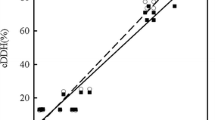Abstract
Two different DNA hybridization methods were used to study the genetic relationships among strains of Chlorella sorokiniana. Closely related strains could be easily detected by comparison of DNA renaturation rates as determined spectrophotometrically, whereas the degree of relationship of more remotely related strains could be determined by means of reassociation of radioactively labelled DNA fragments with high-molecular-weight DNA bound to nitrocellulose filters. Strains assigned to C. sorokiniana proved to be a rather heterogeneous group with only 3 out of 17 strains being closely related to the type strain C. sorokiniana 211-8kT. The description of new species or subspecific taxa on the basis of nucleotide sequence similarities, however, does not seem justified before more detailed knowledge of genome organization in Chlorella is available.
Similar content being viewed by others
Abbreviations
- 1xSSC:
-
standard saline citrate (0.15 M NaCl+0.015 M trisodium citrate, pH 7.0)
- Tris:
-
tris-(hydroxymethyl)-aminomethane
- EDTA:
-
ethylene diamine tetraacetate
- CTAB:
-
N-cetyl-N,N,N-trimethyl ammonium bromide
- TEACl:
-
tetraethyl ammonium chloride
References
Blüthmann H, Brück D, Hübner L, Schöffski A (1973) Reassociation of nucleic acids in solutions containing formamide. Biochem Biophys Res Commun 50:91–97
Brooks RR, Huang PC (1972) Redundant DNA of Neurospora crassa. Biochem Genet 6:41–49
Chang CT, Hain TC, Hutton JR, Wetmur JG (1974) Effects of microscopic and macroscopic viscosity on the rate of renaturation of DNA. Biopolymers 13:1847–1858
Darby GK, Jones AS, Kennedy JF, Walker RT (1970) Isolation and analysis of the nucleic acids and polysaccharides from Clostridium welchii. J Bacteriol 103:159–165
DeLey J (1969) Compositional nucleotide distribution and the theoretical prediction of homology in bacterial DNA. J Theoret Biol 22:89–116
DeLey J, Cattoir H, Reynaerts A (1970) The quantitative measurement of DNA hybridization from renaturation rates. Eur J Biochem 12:133–142
Denhardt DT (1966) A membrane-filter technique for the detection of complementary DNA. Biochem Biophys Res Commun 23:641–646
Gillis M, DeLey J, DeCleene M (1970) The determination of molecular weight of bacterial genome DNA from renaturation rates. Eur J Biochem 12:143–153
Hellmann V, Kessler E (1974) Physiologische und biochemische Beiträge zur Taxonomie der Gattung Chlorella. VIII. Die Basenzusammensetzung der DNS. Arch Microbiol 95:311–318
Howell SH, Walker LL (1976) Informational complexity of the nuclear and chloroplast genomes Chlamydomonas reinhardii. Biochim Biophys Acta 418:249–256
Huss VAR, Festl H, Schleifer KH (1983) Studies on the spectrophotometric determination of DNA hybridization from renaturation rates. Syst Appl Microbiol 4:184–192
Jahnke KD, Bahnweg G (1986) Assessing natural relationships in the Basidiomycetes by DNA analysis. Trans Br Mycol Soc (in press)
Kerfin W, Kessler E (1978) Physiological and biochemical contributions to the taxonomy of the genus Chlorella. XI. DNA hybridization. Arch Microbiol 116:97–103
Kessler E (1967) Physiologische und biochemische Beiträge zur Taxonomie der Gattung Chlorella. III. Merkmale von 8 autotrophen Arten. Arch Mikrobiol 55:346–357
Kessler E (1972) Physiologische und biochemische Beiträge zur Taxonomie der Gattung Chlorella. VII. Die Thermophilie von Chlorella vulgaris f. tertia Fott et Nováková. Arch Mikrobiol 87:243–248
Kessler E (1974) Physiologische und biochemische Beiträge zur Taxonomie der Gattung Chlorella. IX. Salzresistenz als taxonomisches Merkmal. Arch Microbiol 100:51–56
Kessler E (1978) Physiological and biochemical contributions to the taxonomy of the genus Chlorella. XII. Starch hydrolysis and a key for the identification of 13 species. Arch Microbiol 119:13–16
Kessler E (1982) Chemotaxonomy in the Chlorococcales. In: Round FE, Chapman DJ (eds) Progress in phycological research, vol 1. Elsevier Biomedical Press B. V., Amsterdam, pp 111–135
Kessler E (1984) A general review on the contribution of chemotaxonomy to the systematics of green algae. In: Irvine DEG, John DM (eds) Systematics of the green algae. Systematics Association, Special vol 27. Academic Press, London Orlando, pp 391–407
Kessler E, Czygan FC (1970) Physiologische und biochemische Beiträge zur Taxonomie der Gattung Chlorella. IV. Verwertung organischer Stickstoffverbindungen. Arch Mikrobiol 70:211–216
Kessler E, Zweier I (1971) Physiologische und biochemische Beiträge zur Taxonomie der Gattung Chlorella. V. Die auxotrophen und mesotrophen Arten. Arch Mikrobiol 79:44–48
Marmur J (1961) A procedure for the isolation of deoxyribonucleic acid from microorganisms. J Mol Biol 3:208–218
Martini A, Phaff HJ (1973) The optical determination of DNA-DNA homologies in yeasts. Ann Microbiol Enzimol 23:59–68
Melchior WB Jr, Hippel PH von (1973) Alteration of the relative stability of dA·dT and dG·dC base pairs in DNA. Proc Natl Acad Sci USA 70:298–302
Meyer SA, Schleifer KH (1978) Deoxyribonucleic acid reassociation in the classification of coagulase-positive Staphylococci. Arch Microbiol 117:183–188
Orosz JM, Wetmur JG (1977) DNA melting temperatures and renaturation rates in concentrated alkylammonium salt solutions. Biopolymers 16:1183–1199
Owen RJ, Hill LR, Lapage SP (1969) Determination of DNA base compositions from melting profiles in dilute buffers. Biopolymers 7:503–516
Price CW, Fuson GB, Phaff HJ (1978) Genome comparison in yeast systematics: Delimitation of species within the genera Schwanniomyces, Saccharomyces, Debaryomyces, and Pichia. Microbiol Rev 42:161–193
Rigby PWJ, Dieckmann M, Rhodes C, Berg P (1982) Labeling deoxyribonucleic acid to high specific activity in vitro by nick translation with DNA polymerase I. J Mol Biol 113:237–251
Schleifer KH, Stackebrandt E (1983) Molecular systematics of prokaryotes. Ann Rev Microbiol 37:143–187
Schlösser UG (1982) Sammlung von Algenkulturen. Ber Dt Bot Ges 95:181–276
Author information
Authors and Affiliations
Rights and permissions
About this article
Cite this article
Huss, V.A.R., Dörr, R., Grossmann, U. et al. Deoxyribonucleic acid reassociation in the taxonomy of the genus Chlorella . Arch. Microbiol. 145, 329–333 (1986). https://doi.org/10.1007/BF00470866
Received:
Accepted:
Issue Date:
DOI: https://doi.org/10.1007/BF00470866




